
In a landmark ruling, an Oklahoma judge has ordered Johnson & Johnson to pay $572 million for contributing to the state’s opioid crisis. It marks the first time a drug company has been held responsible for the opioid crisis, though it fell far short of the $17 billion judgment sought by the state. According to the Centers for Disease Control and Prevention, almost 400,000 people died from an overdose involving opioids from 1999 to 2017, including from prescription and illicit opioids. Court documents say more than 6,000 people have died of painkiller overdoses in Oklahoma alone. The Oklahoma ruling sets the stage for the more than 40 states that are currently pursuing similar claims against drug makers and distributors. A massive federal lawsuit brought by almost 2,000 cities, counties and Native American tribes is scheduled to begin in October. We speak with Julia Lurie, senior reporter at Mother Jones, who has covered the opioid crisis for years.
Transcript
AMY GOODMAN: In a landmark ruling, an Oklahoma judge has ordered Johnson & Johnson to pay $572 million for contributing to Oklahoma’s opioid crisis. Oklahoma District Judge Thad Balkman announced the ruling Monday.
JUDGE THAD BALKMAN: The opioid crisis is an imminent danger and menace to Oklahomans. My judgment includes findings of fact and conclusions of law that the state met its burden that the defendants Janssen and Johnson & Johnson’s misleading marketing and promotion of opioids created a nuisance as defined by 50 O.S. Section 1, including a finding that those actions compromised the health and safety of thousands of Oklahomans. Specifically, defendants caused an opioid crisis that is evidenced by increased rates of addiction, overdose deaths and neonatal abstinence syndrome in Oklahoma. This is a temporary public nuisance that can be abated. And the proper remedy for public nuisance is equitable abatement. As I just stated, the opioid crisis has ravaged the state of Oklahoma. It must be abated immediately. For this reason, I am entering an abatement plan that consists of costs totaling $572,102,028 to immediately remediate the nuisance.
AMY GOODMAN: Oklahoma Judge Thad Balkman, speaking Monday. Johnson & Johnson has vowed to appeal the ruling. This marks the first time a drug company has been held responsible for the opioid crisis, which has led to more than 400,000 overdose deaths since 1999. According to court documents, more than 6,000 people have died of painkiller overdoses in Oklahoma alone. The state of Oklahoma had sought a $17 billion judgment, but Oklahoma Attorney General Mike Hunter still celebrated the ruling.
ATTORNEY GENERAL MIKE HUNTER: Today, Judge Balkman has affirmed our position that Johnson & Johnson, motivated by greed and avarice, is responsible for the opioid epidemic in our state. Johnson & Johnson will finally be held accountable for thousands of deaths and addiction caused by their activities. … There is no question in my mind that we had to bring this case, that it had to be tried, that these facts had to see sunlight. That’s been accomplished here. And at the end of the day, you can’t sit in a corporate suite somewhere for the last 20 years and oversupply the country. Ten times more of this drug was coming in, and then you had, concomitantly, 15 times more people dying from opioid overdoses. So, there’s no question in my mind that these companies knew what was going on at the highest level. They just couldn’t quit making money from it. And that’s why they’re responsible.
AMY GOODMAN: The Oklahoma ruling sets the stage for the more than 40 states that are currently pursuing similar claims against the pharmaceutical industry, lawsuits targeting drug makers and distributors. A massive federal lawsuit, brought by almost 2,000 cities, counties and Native American tribes, is scheduled to begin in October in Cleveland.
Well, for more, we go to San Francisco, California, where we’re joined by Julia Lurie, a senior reporter at Mother Jones. Her new article, “Johnson and Johnson Was Just Found Liable for Fueling the Opioid Epidemic in a Historic Trial.”
Julia Lurie, welcome to Democracy Now! You’ve been following this trial very closely. Talk about the significance of the ruling.
JULIA LURIE: So, this ruling is huge. This is the first time that a case like this has gone to trial. And, you know, honestly, we didn’t really know what was going to happen. There is not really a precedent for this, for a pharmaceutical company being held liable for its role in this crisis. So, you know, you had all of this evidence that was being put out over the past several weeks, and still we didn’t really know how the judge was going to come down. And so, the news yesterday, that the state was going to be receiving millions of dollars from Johnson & Johnson, was really impressive. And at the same time, you know, the state had requested a lot more money. So, it’s definitely, I think, a mixed bag, but, overall, it definitely sets the tone for future cases like this, of which there will be many.
AMY GOODMAN: Now, it’s not as if this was the only drug company that contributed to the opioid crisis. But two other companies, Purdue Pharma and Teva, had settled with Oklahoma before, at less than — well under half the amount that this judge has now found Johnson & Johnson liable for.
JULIA LURIE: Correct. So, Johnson & Johnson was basically making the gamble that the state could not find a single company, namely Johnson & Johnson, liable for the entirety of the opioid crisis, that their role was so minuscule that they would not be found responsible. And that strategy really ended up backfiring, because, as you said, they ended up paying far more than Purdue and Teva combined.
AMY GOODMAN: On Monday, Johnson & Johnson’s attorney Sabrina Strong vowed to appeal the ruling.
SABRINA STRONG: We have sympathy for all who suffer from substance abuse, but Johnson & Johnson did not cause the opioid abuse crisis here in Oklahoma or anywhere in this country. We do not believe that the facts or the law supports the decision today. We have many strong grounds for appeal, and we intend to pursue those vigorously.
AMY GOODMAN: That’s Johnson & Johnson’s attorney Sabrina Strong vowing to appeal the ruling. Julia Lurie, one of the main arguments of Johnson & Johnson is “We didn’t prescribe these drugs; doctors did.”
JULIA LURIE: That’s true, and at the same time, Johnson & Johnson played a big role in getting those doctors to prescribe these drugs. So, what we now know from the evidence that was laid out in this trial was that Johnson & Johnson was a pharmaceutical company that went about a massive and misleading and false advertising, effectively, marketing campaign, in which they had sales representatives target high-volume prescribers, so doctors that they knew would be amenable to prescribing more and more opioids, and encouraging those doctors to prescribe higher doses of opioids, and also trying to convince folks, doctors and patients alike, that these were safe and effective drugs, that they were — that addiction was not a problem, that it was perfectly fine to take them at high doses for long periods of time. You know, one of the things that came out over the course of this trial was that Johnson & Johnson representatives, sales representatives, made — I think it was 150,000 calls just across the state of Oklahoma, sales calls, to doctors, pushing them to prescribe these opioids. And so, you know, it’s correct that ultimately the doctors are the ones that are prescribing these drugs; however, Johnson & Johnson played a huge role in influencing those doctors.
And another thing that we know that Johnson & Johnson did was support the pain patients, the advocacy groups, specifically, that were advocating on behalf of pain patients. You know, when a message is coming from a doctor or from a patient advocacy group, it seems much more trustworthy than a message coming from a pharmaceutical company. So we know that they really leveraged those messaging techniques. And as a result, the prescribing of opioids in Oklahoma, and really across the country, skyrocketed.
AMY GOODMAN: Oklahoma also argued that Johnson & Johnson targeted young children in its efforts to expand the opioid market. The state compared the company’s recruiting tactics to those of the tobacco industry. Julia, tell us more.
JULIA LURIE: So, it seems like there was no population that was sort of off limits for Johnson & Johnson to basically push these opioids onto. And, you know, from a marketing perspective, it makes sense. If you can get more people hooked on these drugs, especially people from a younger age, then you’ll have, you know, lifetime customers, as it were. However, as we know, these drugs are extraordinarily addictive, and there are all sorts of negative effects to prescribing these drugs. So, you know, we have all this marketing information now, that if you were just taking an economic perspective, you would say, “Oh, yeah, that makes sense. Target as many different populations as you can. Target people with cancer pain. Target people with noncancer pain. Target old people. Target young people.” And in reality, that kind of targeting has really devastating consequences.
AMY GOODMAN: You wrote a piece not a little while ago called “Inside Johnson and Johnson’s Quiet Domination of the Opioid Market.” Explain how key Johnson & Johnson was and how this market and the epidemic developed simultaneously. How did they do it? There is so much that is not known about the way these companies operate, with their secret documents, that now come out in trial.
JULIA LURIE: Sure. So, the company’s role was really multipronged. So, on the one hand, they had their own opioid products that they were selling and they were marketing, and they had a whole salesforce of folks who were going to doctors and encouraging doctors to prescribe those medications. But also — and this is something that I think that most people don’t know about Johnson & Johnson — Johnson & Johnson had two subsidiaries that were responsible for manufacturing the majority of active ingredients in opioids that were marketed and sold in the United States, not just Johnson & Johnson opioids but all sorts of opioids.
So, the way that they did this was, back in the '90s they had developed this high-thebaine poppy. Thebaine is a type of opioid that's used in a lot of painkillers. And back in the ’90s, they were able to connect with what is now Purdue Pharma to basically say, “Look, we have all these poppies. We have this active ingredient. We can help you to make this opioid painkiller, and we can supply as much of it as you want.” And over the years, you know, Johnson & Johnson subsidiaries ended up providing pharmaceutical companies across the country with 60% of the active ingredients that are in painkillers.
So, you know, on the one hand, you have Johnson & Johnson with its own painkillers and with its own salesforce, but they also were quietly playing this really massive role in providing the entirety of the United States and its pharmaceutical companies with the active ingredients that ended up in painkillers in medicine cabinets all over the country.
AMY GOODMAN: I also wanted to ask about Purdue Pharma’s role in the opioid crisis. Again, they settled earlier and didn’t go to trial in Oklahoma. Earlier today, the investigative news organization ProPublica published video testimony of Dr. Richard Sackler of Purdue Pharma, the maker of OxyContin. This is a part of a deposition he gave in a 2015 lawsuit in Kentucky. The company waged a three-year legal battle to keep this video secret.
TYLER THOMPSON: Sitting here today, after all you’ve come to learn as a witness, do you believe Purdue’s conduct in marketing and promoting OxyContin in Kentucky caused any of the prescription drug addiction problems now plaguing the commonwealth?
DR. RICHARD SACKLER: I don’t believe so.
TYLER THOMPSON: Sitting here today, after all you’ve come to learn as a witness, do you believe that Purdue’s conduct in Kentucky has led to an excessive or unnecessary amount of opioids being located throughout the commonwealth of Kentucky?
DR. RICHARD SACKLER: I don’t believe so.
TYLER THOMPSON: Do you believe that any of Purdue’s conduct has led to an increase in people being addicted in the commonwealth of Kentucky?
DR. RICHARD SACKLER: No.
AMY GOODMAN: That’s Dr. Richard Sackler of Purdue Pharma, the maker of OxyContin, again, part of a deposition he gave in a 2015 lawsuit in Kentucky. They did not want this video made public. Julia Lurie, as you listen to this for the first time, can you talk about the significance of his testimony in this affidavit?
JULIA LURIE: You know, on the one hand, it seems completely absurd that he would say that, and, on the other, that company has really stuck to those lines, that “we are not responsible for this addiction crisis” and “we’re not responsible for this overdose crisis.” So, in that way, it’s very on brand.
And, you know, with this crisis, overall, it’s complicated, because you have so many different companies that were playing a role in this, from Purdue Pharma and Johnson & Johnson and other pharmaceutical companies to the pharmaceutical distributors, who were responsible for taking pills from those pharmaceutical companies and distributing them to pharmacies across the country. And then you have the pharmacies, who were not responsible with making sure that these pills got into the right hands. And you have doctors who were overprescribing. There are so many places where the system failed. And Purdue has basically stuck to the line that, like, “Look, we just manufacture this one drug. How can we be responsible for this entire crisis that has subsequently unfolded?”
AMY GOODMAN: So, you now have the next series of lawsuits, and we’re talking about thousands and thousands of lawsuits. One case that’s going forward in Cleveland in October is actually 2,000 lawsuits brought together, brought by cities, counties and Native American tribes. Talk about the significance of this coming up and what this trial and verdict mean for the Cleveland trial.
JULIA LURIE: Sure. So, you know, over the past few years, municipalities, whether it’s cities or counties or tribal lands, have been paying financially for the cost of this crisis. It is very, very expensive to put people in treatment, to have the emergency services that are necessary when someone overdoses, to have the drug courts that folks go to when they’re dealing or using drugs. And so, for all of those things, they take a lot of money, and a lot of counties are really struggling with this. They don’t have the financial means to deal with this, or it’s cutting into budgets that they had for other things. So, over the years, a number of places have sued pharmaceutical companies for causing this crisis, and basically said, “Look, you are costing us all of this money. You’re causing this widespread devastation. And you need to pay up. You need to be responsible for this.”
So, all of those — or, a lot of those cases have been sort of rolled together into one big multidistrict litigation, that is going to trial in October. And this is going to be a huge case. It is — like you said, it is about 2,000 municipalities that are suing, and there are a ton of defendants — a lot of pharmaceutical companies, as well as distributors. And it’s expected that a lot of evidence against a number of pharmaceutical companies and distributors will come out during this trial.
We don’t know yet where things stand, if some places are going to — if some defendants are going to settle, if this is going to lead some companies into bankruptcy, if it’s not going to be a big deal. We don’t know. What we do know is that this trial that just happened in Oklahoma really sets the tone and sets a precedent for what this multidistrict litigation could be like. In Oklahoma, the lawyers for Oklahoma, the prosecutors, were basically saying that this was a public nuisance. They were basing their argument on the idea that the public nuisance that was created by Johnson & Johnson was so expensive that the company had to pay up. And that is a strategy that we didn’t know if that was going to hold up in court or not. And now that we know that, at least in this one case, it did, it’s expected that the lawyers for the defendants [sic] in the multidistrict litigation will also stick to that strategy.
AMY GOODMAN: And just to be clear, this was a nonjury case, right? This was a judge —
JULIA LURIE: Correct.
AMY GOODMAN: — made this decision. These pharmaceutical companies are, it seems, terrified of a jury of someone’s peers, of a victim’s peers.
JULIA LURIE: Correct. And the multidistrict litigation will be a jury. They will have a jury in that case.
AMY GOODMAN: Well, Julia Lurie, I want to thank you so much for being with us, senior reporter at Mother Jones. We’ll link to your new piece, “Johnson and Johnson Was Just Found Liable for Fueling the Opioid Epidemic in a Historic Trial.”
When we come back, following the death of billionaire right-wing donor David Koch, we look at how he and his brother Charles transformed the U.S. economy and political system, from funding climate change deniers to fighting organized labor. We’ll speak with the author of a new book, Kochland: The Secret History of Koch Industries and Corporate Power in America. Stay with us.

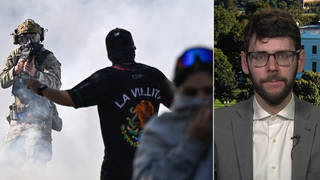

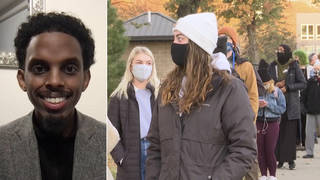
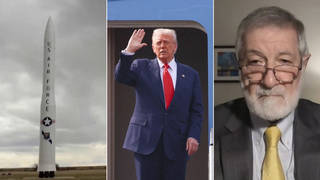





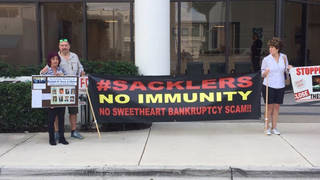
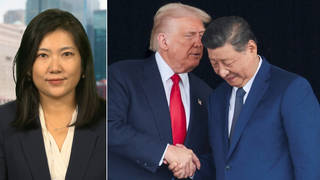
Media Options